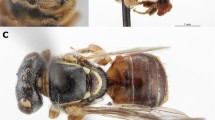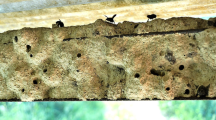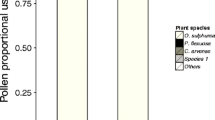Abstract
Associations between bees and termites are documented infrequently, but records are available for bee species ranging in behavior from solitary to highly eusocial. The subtribe Meliponina (stingless bees) is the most common bee group reported in termite nests, and, for some species, the occupancy of termite nests may be obligatory. The records of solitary bees nesting within termite nests include species of the tribes Emphorini, Centridini, Megachilini, and Paracolletini. Most of these bees can probably nest in other substrates, and their relationships with termite nests are presumably opportunistic. This study provides a review of published records of bees as guests in termite nests, and also describes the aggregation of nests of Gaesochira obscura within one nest of Anoplotermes banksi in Brazilian Amazonia. One termite nest contained at least ten nest entrances of G. obscura, with burrows 4–6 mm in diameter and about 10 cm long. Each burrow ended in brood cells in different stages of food provisioning and larval development. As commonly reported for other associations of this nature, there was no connection between the tunnels of bees and those of termites. This record adds important data on the biology of A. banksi. Because this is a single record, it is impossible to classify G. obscura either as a termitophile or termitariophile; this species may be opportunistic in relation to nesting substrate.


Similar content being viewed by others

References
Araujo R.L. 1970. Termites of the Neotropical region. In: Biology of Termites, Vol. II (Krishna K. and Weesner F.M., Eds), Academic Press, New York. pp 527–576
Barreto L.S. and Castro M.S. 2007. Ecologia de nidificação de abelhas do gênero Partamona (Hymenoptera: Apidae) na caatinga, Milagres, Bahia. Biot. Neotrop. 7: 87–92
Bennet F.D. 1964. Notes on the nesting site of Centris derasa (Hymenoptera; Apoidea). Pan-Pac. Entomol. 49: 125–135
Berg K. 1900. Termitariophilie. Comm. Mus. Nacl. Buenos Aires 1: 212–215
Bourguignon T., Šobotník J., Lepoint G., Martin J.M. and Roisin Y. 2009 Niche differentiation among neotropical soldierless soil-feeding termites revealed by stable isotope ratios. Soil Biol. Biochem. 41: 2038–2043
Callan E.C. 1977. Observations on Centris rufosuffusa Cockerell (Hymenoptera: Anthophoridae) and its parasites. J. Nat. Hist. 11: 127–135
Camargo J.M.F. 1984. Notas sobre hábitos de nidificação de Scaura (Scaura) latitarsis (Friese). Bol. Mus. Paraense Emilio Goeldi, Zool. 1: 89–95
Camargo J.M.F. 1970. Ninhos e biologia de algumas espécies de meliponídeos (Hymenoptera: Apidae) da região de Porto Velho, Território de Rondônia, Brasil. Ver. Biol. Tropic. 16: 207–239
Camargo J.M.F. 1980. O grupo Partamona (Partamona) testacea (Klug): suas espécies, distribuição e diferenciação geográfica. Acta Amazon. 10: 1–175
Camargo J.M.F. and Moure J.S. 1994. Meliponinae neotropicais: Os gêneros Paratrigona Schwarz, 1938 e Aparatrigona Moure, 1951. Arq. Zool. 32: 33–109
Camargo J.M.F. and Pedro S.R.M. 2003. Meliponini neotropicais: o gênero Partamona Schwarz, 1939 (Hymenoptera, Apidae, Apinae) - bionomia e biogeografia. Rev. Bras. Entomol. 47: 311–372
Camargo J.M.F. and Posey D.A. 1990. O conhecimento dos Kayapó sobre as abelhas sociais sem ferrão (Meliponinae, Apidae, Hymenoptera): notas adicionais. Bol. Mus. Paraense Emílio Goeldi, Zool. 6: 17–42
Cardinal S., Straka J. and Danforth B.N. 2010. Comprehensive phylogeny of apid bees reveals the evolutionary origins and antiquity of cleptoparasitism. Proc. Natl Acad. Sci. USA 107: 16207–16211
Constantino R. 1999. Chave ilustrada para a identificação dos gêneros de cupins (Insecta: Isoptera) que ocorrem no Brasil. Pap. Avulsos Zool. 40: 387–448
Constantino R. 2005. Padrões de diversidade e endemismo de térmitas no bioma cerrado. In: Biodiversidade, ecologia e conservação do Cerrado (Scariot A.O., Silva J.C.S. and Felfili J.M., Eds), Ministério do Meio Ambiente, Brasília. pp 319–333
Constantino R. and Acioli A.N.S. 2006. Termite diversity in Brazil (Insecta: Isoptera). In: Soil biodiversity in Amazonian and other Brazilian Ecosystems (Moreira F., Siqueira J.O. and Brussaard L., Eds), CAB International, Wallingford. pp 117–128
Corville R.E., Gordon W.F. and Vinson B.S. 1983. Nests of Centris segregata (Hymenoptera: Anthophoridae) with a review of the nesting habits of the genus. J. Kans. Entomol. Soc. 56: 109–122
Costa C. and Vanin S.A. 2010. Coleoptera larval fauna associated with termite nests (Isoptera) with emphasis on the “bioluminescent termite nests” from Central Brazil. Psyche 2010: 1–13
Costa D.A., Carvalho R.A., Lima Filho G.F. and Brandão D. 2009. Inquilines and invertebrate fauna associated with termite nests of Cornitermes cumulans (Isoptera, Termitidae) in the Emas National Park, Mineiros, Goiás, Brazil. Sociobiology 53: 443–453
Deligne J., Quennedey A. and Blum M.S. 1981. The enemies and defense mechanisms of termites. In: Social Insects, Vol. II (Hermann H.R., Ed), Academic Press, New York. pp 1–76
Dodson C.H. 1966. Ethology of some bee of the tribe Euglossini (Hymenoptera; Apidae). J. Kans. Entomol. Soc. 39: 507–629
Eardley C.D. 2004. Taxonomic revision of the African stingless bees. Afr. Plant. Prot. 10: 63–96
Eggleton P. 2000. Global patterns of termite diversity. In: Termites: Evolution, Sociality, Symbioses, Ecology (Abe T., Bignell D.E. and Higashi M., Eds), Kluwer Academic Publishers, Dordrecht. pp 25–53
Emerson A.E. 1925. The termites from Kartabo, Bartica District, British Guiana. Zoologica 6: 291–459
Gaglianone M.C. 2001. Nidificação e forrageamento de Centris (Ptilotopus) scopipes Friese. Rev. Bras. Zool. 18: 107–117
Grassé P.P. 1986. Termitologia, Tome III. Comportement, Socialité, Ecologie, Evolution, Systématique. Masson, Paris.
Higashi M. and Abe T. 1997. Global diversification of termites driven by the evolution of symbiosis and sociality. In: Biodiversity: an ecological perspective (Abe T., Levin S.A. and Higashi M. Eds), Springer, New York, pp 83–112
Kerr W.E., Sakagami S.F., Zucchi R., Portugal-Araujo V. and Camargo J.M.F. 1967. Observações sobre a arquitetura dos ninhos e comportamento de algumas espécies de abelhas sem ferrão das vizinhanças de Manaus, Amazonas. Acta Simp. Biota Amazônica, Zool. 5: 255–309
Kimsey L.S. 1982. Systematics of bees of the genus Eufriesea (Hymenoptera, Apidae). Univ. Calif. Publ. Entomol. 95: 1–125
Kistner D.H. 1979. Social and evolutionary significance of social insect symbionts. In: Social insects, Vol. I (Hermann H.R., Ed), Academic Press, New York. pp 339–413
Kistner D.H. 1982. The social insect’s bestiary. In: Social Insects, Vol. III (Hermann H.R., Ed), Academic Press, New York. pp 1–244
Kistner D.H. 1969. The biology of termitophiles. In: Biology of Termites, Vol. I (Krishna K. and Weesner F.M., Eds), Academic Press, New York. pp 525–557
Laroca S., Reynaud dos Santos D.T. and Schwartz Filho D.L. 1993. Observations on the nesting biology of three Brazilian Centridini bees: Melanocentris dorsata (Lepeletier 1841), Ptilotopus sponsa (Smith 1854) and Epicharitides obscura (Friese 1899) (Hymenoptera Anthophoridae). Trop. Zool. 6: 151–163
Lenko K. 1971. Nota bionômica sobre a abelha Trigona recursa F. Smith (Hymenoptera: Apidae). Arq. Inst. Biol. 38: 75–77
Martius C. and Ribeiro J.d’A. 1996. Colony populations and biomass in nests of the Amazonian Forest termite Anoplotermes banksi Emerson (Isoptera: Termitidae). Stud. Neotrop. Fauna Environm. 31: 82–86
Maynard G. and Rao S. 2010. The solitary bee, Leioproctus (Leioproctus) nigrofulvus (Cockerell 1914) (Hymenoptera: Colletidae), in SE Australia: Unique termite-mound-nesting behavior and impacts of bushfires on local populations. Pan-Pac. Entomol. 86: 14–19
Melo G.A.R. and Gonçalves R.B. 2005. Higher-level bee classifications (Hymenoptera, Apoidea, Apida sensu lato). Rev. Bras. Zool. 22: 153–159
Messer A.C. 1984. Chalicodoma pluto: the world`s largest bee rediscovered living communally in termite nests (Hymenoptera: Megachilidae). J. Kans. Entomol. Soc. 57: 165–168
Michener C.D. 2000. The Bees of the World. John Hopkins University Press, Baltimore, Maryland.
Michener C.D. 2007. The Bees of the World, 2nd Ed. John Hopkins University Press, Baltimore, Maryland.
Michelette E.R.F., Camargo J.M.F. and Rozen J.G. 2000. Biology of the bee Canephorula apiformis and its cleptoparasite Melectoides bellus: nesting habits, floral preferences, and mature larvae (Hymenoptera, Apidae). Am. Mus. Nov. 3308: 1–23
Moure J. 1967. A new genus and two new species of eucerine bee from South America (Hymenoptera, Apoidea). Dusenia 8: 147–152
Pickel B. 1928. Contribuição para a biologia de Centris sponsa e Acanthopus excellens (Hymen.). Bol. Biol. 14: 135–143
Posey D.A. and Camargo J.M.F. 1985. Additional notes on the classification and knowledge of stingless bees (Meliponinae, Apidae, Hymenoptera) by the Kayapó Indians of Gorotire, Pará, Brazil. Ann. Carnegie Mus. 54: 247–274
Prestwich G.D. 1984. Defense mechanisms of termites. Annu. Ver. Entomol. 29: 201–232
Ramos M., Mendes F., Aluquerque P. and Rêgo M. 2007. Nidificação e forrageamento de Centris (Ptilotopus) maranhensis Ducke (Hymenoptera, Apidae, Centridini). Rev. Bras. Zool. 24: 1006–1010
Ratnieks F.L.W., Piery M.A. and Cuadrielo I. 1991. The natural nest and nest density of the Africanized Honey Bee (Hymenoptera, Apidae) near Tapachula, Chiapas, Mexico. Can. Ent. 123: 353–359
Redford K.H. 1984. The Termitaria of Cornitermes cumulans (Isoptera, Termitidae) and their role in determining a potential keystone species. Biotropica 16: 112–119
Roisin Y. and Pasteels J.M. 2000. The genus Microcerotermes (Isoptera: Termitidae) in New Guinea and the Solomon Islands. Invertebr. Taxon. 14: 137–174
Roubik D.W. 1979. Nest and colony characteristics of stingless bees from French Guiana (Hymenoptera: Apidae). J. Kans. Entomol. Soc. 53: 443–470
Roubik D.W. 1983. Nest and colony characteristics of stingless bees from Panama. J. Kans. Entomol. Soc. 56: 327–355
Rozen J.G. 1965. The larvae of the Anthophoridae (Hymenoptera, Apoidea). Part 1. Introduction, Eucerini, and Centridini (Anthophorinae). Am. Mus. Nov. 2233: 1–27
Rozen J.G. 1969. The larvae of the Anthophoridae (Hymenoptera, Apoidea). Part 3. The Melectini, Ericrocini, and Rhathymini. Am. Mus. Nov. 2382: 1–24
Rozen J.G. 1991. Nesting biology and mature larva of the bee Idiomelissodes duplocincta (Hymenoptera: Anthophoridae: Eucerini). Am. Mus. Nov. 3012: 1–11
Rozen J.G. and Ayala R. 1987. Nesting biology of the squash bee Peponapis utahensis (Hymenoptera; Anthophoridae; Eucerini). J. N.Y. Entomol. Soc. 95: 28–33
Schwarz M. 1948. Stingless bees (Meliponidae) of the Western Hemisphere. Bull. Am. Mus. Nat. Hist. 90: 1–546
Silvestri F. 1903. Contribuzione alla conoscenza dei Termiti e Termitofili dell’America Meridionale. Redia 1: 1–234
Silveira F.A., Melo G.A.R. and Almeida E.A.B. 2002. Abelhas Brasileiras: Sistemática e Identificação. Silveira, Belo Horizonte. 253 pp
Smith F. 1879. Descriptions of New Species of Hymenoptera in the Collection of the British Museum. British Museum, London. 240 pp
Smith F. 1854. Notes on the biology and waxes of four species of African Trigona bees (Hymenoptera: Apidae). Proc. R. Entomol. Soc. Lond. 29: 62–70
Sobotník J., Jirsová A. and Hanus R. 2010. Chemical warfare in termites. J. Insect Physiol. 56: 1012–1021
Vesey-Fitzgerald D. 1939. Observations on bees (Hymenoptera: Apoidea) in Trinidad, BWI. Proc. R. Entomol. Soc. Lond. 14: 107–110
Wille A. and Michener C.D. 1973 The nest architecture of stingless bee with special reference to those of Costa Rica. Rev. Biol. Trop. 21: 1–278
Wilson E.O. 1971. The Insect Societies. Belknap Press, Cambridge.
Acknowledgments
We are very grateful to PROBIOTA Consultoria Ambiental and Santo Antônio Energia for the execution of the Entomological Monitoring Program from Santo Antônio UHE, and full support in the field during the report of the association between Gaesochira obscura and Anoplotermes banksi. Partial support was provided by Coordenação de Aperfeiçoamento de Pessoal de Nível Superior (CAPES), Ph.D. scholarship (to TFC) and Fundação de Amparo à Pesquisa do Estado de São Paulo (FAPESP), Ph.D. Scholarship 07/01296-0 (to RBG). Special thanks for Jerome G. Rozen Jr., Eliana M. Cancello, Felipe Vivallo, the Associate Editor of this Journal, Miriam Richards, and an anonymous review for comments on the manuscript.
Author information
Authors and Affiliations
Corresponding author
Rights and permissions
About this article
Cite this article
Carrijo, T.F., Gonçalves, R.B. & Santos, R.G. Review of bees as guests in termite nests, with a new record of the communal bee, Gaesochira obscura (Smith, 1879) (Hymenoptera, Apidae), in nests of Anoplotermes banksi Emerson, 1925 (Isoptera, Termitidae, Apicotermitinae). Insect. Soc. 59, 141–149 (2012). https://doi.org/10.1007/s00040-012-0218-x
Received:
Revised:
Accepted:
Published:
Issue Date:
DOI: https://doi.org/10.1007/s00040-012-0218-x



